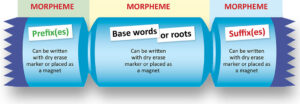Phonemes and graphemes
If you have been teaching reading and spelling in line with evidence, then you’re familiar with the –emes; phonemes and graphemes that make up the –ology that we’ve all become very used to teaching, talking about and assessing – phonology! Phonology is non-by-passable stage of reading and spelling development, but we know that it’s only part of the picture with developing proficient readers and spellers.
Morphemes
Well, there’s a new –ology in town, morphology! But really, morphology is not a new invention, it’s always been right there in our spelling system all along. Those in the Specific Learning Difficulties space have been referring to research for over a decade that has been showing the benefits of building morphology into intervention teaching sequences. Orton-Gillingham (OG) based programs that date back to the 1930s have always contained a strong morphology component alongside their strong focus on phonology.
Morphemes have been right there in our words, providing readers with all sorts of important information in the form of affixes, that can tell us when something happened: <-ing> / <-ed> / <pre->), how many of something: (<-s> / <-es>) or, what someone or something does (<-er> / <-or>). Morphology also gives the reader important information about the base meaning of words like transportable, that is made of three morphemes, telling us that:
- something is able…suffix <-able>…
- to be carried…base <port> …
- across or through something…prefix <trans->




A morphological look at the word transportable gets our brain shooting off in all directions about other words that contain the base <port>, meaning to carry or bear. All of a sudden, words like report, import, export, and deport spring to mind, and we begin to wonder about how their meanings are determined by their morphemes:
- <re-> a prefix meaning again or back…
- <ex-> meaning out of…
- <im-> meaning in to
Then it occurs to us that the act of reporting something relates to carrying information back!
But… those are straight forward examples of how words are made up of these small units of meaning called morphemes. There are words we use daily but never really think about their possible morphemes. The word exit happens to consist of the prefix <ex-> and base <it>, that in this instance means to move. Exit = to move out of!
Another example of hidden units of meaning is the word happy. Believe it or not, this too is made up of two morphemes, the base <hap>, an unused word in today’s vernacular that means luck and the common suffix <-y> that forms an adjective. The letter ‘p’ is doubled before the addition of suffix <-y> as this is the doubling rule that happens in words like running, swimming and bitten.



